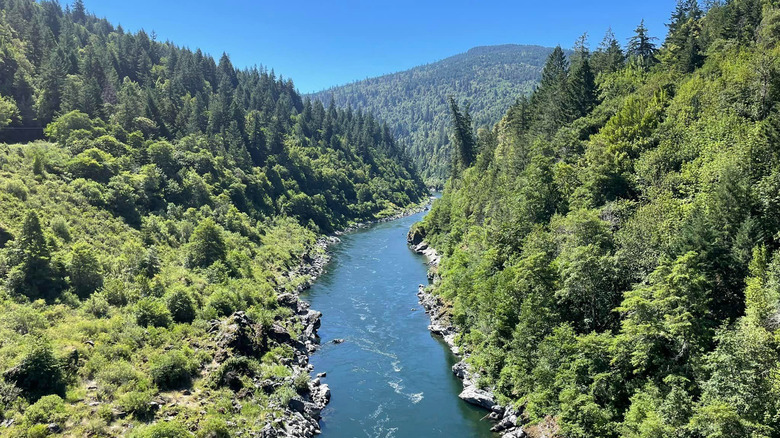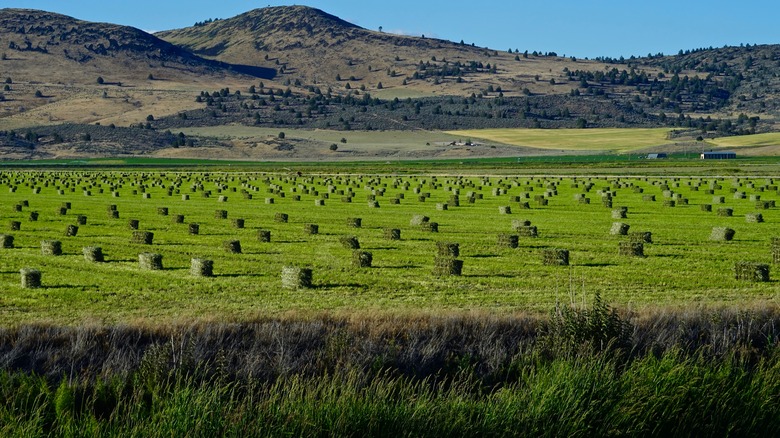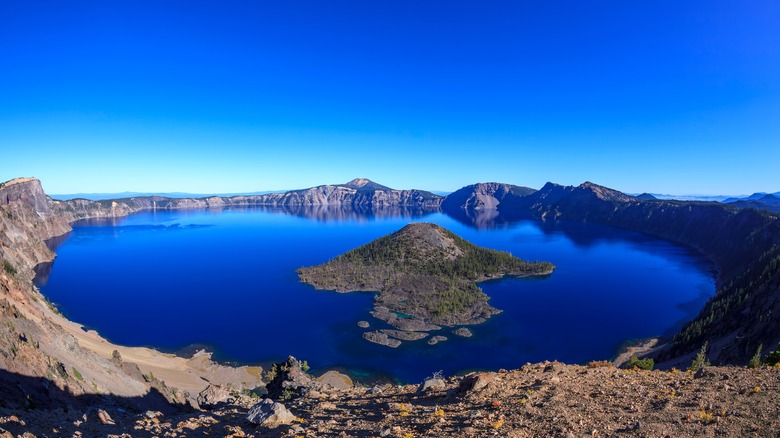Southern Oregon's Sun-Soaked Region Offers Fabulous Farm-To-Table Dining, Wine, Mountains, And Wild Beauty
When sun seekers head to the West Coast, they're often drawn to the surf-licked beaches of San Diego or the luxurious oceanfront homes of Malibu (if the budget allows, of course). The Beaver State is oft-overlooked because it's got a bit of a rep for constant precipitation, and there's a raindrop of truth to that — Portland, Oregon, gets around 36 inches of annual rain on average compared to San Francisco's 23.6 inches. But there's a region in Southern Oregon that clocks over 300 days of sunshine every year and offers oodles of outdoorsy pursuits to match. It's name? The Klamath Basin.
The region ranges from the eastern front of the Oregon Cascades across high desert plains, straddling its namesake river as it flows south over the state line into California. The land is rich in natural resources, peppered with lakes, carved through by tributary rivers, and famed for its fertile soils. It's hardly a wonder that it's risen to become one of the hubs of Oregon's local food movement — there are more organic farm shops and foodie ranches here than you can shake Klamath potato at!
The so-called "City of Sunshine" that is Klamath Falls is the hub of the whole area. That's just a 90-minute drive from the Rogue Valley International Medford Airport, which has some short-haul links to other U.S. destinations. It's also the same distance to Interstate 5, which can help you get to the Klamath Basin from Portland in roughly 4.5 hours or in from Sacramento in just under five hours.
Get your fill of farm-grown food in Klamath Falls
The story of the Klamath Basin is one farming. It all began in 1902, when then-president Roosevelt issued a decree that the region's lakes and bogs could be drained to make way for ranches. Fast forward to today and it's possible to find everything from sugar beets and kale to fodder crops shooting from the ground. And then there are the potatoes, which have been one of the defining crops of Klamath Falls for many decades, accounting for over 7,000 acres of growing space throughout the basin.
The point is that organic, farm-grown food is bursting from every sun-splashed field here, and that translates to one hefty offering for foodies. Klamath Grown, a not-for-profit dedicated to nurturing a local community of growers in the basin, publishes an annual Klamath Grown Guide listing oodles of taste-bud-tingling spots. It includes Basin Levian, for artisan sourdough in Klamath Falls, Fresh Green Organic Garden, for microgreens and veg raised by a fourth generation Klamath farmer, and Maranatha Farm, for all your cantaloupe needs.
Don't forget that this is wine country, too. A blend of mountain fog and varying highland temperatures give Klamath a unique environment for viticulture. Check out the big cabernet sauvignons and merlot blends at 12 Ranch Wines. Or drop into Volcanic Winery for old-world grape types grown by a former potato farmer.
Explore the vast outdoors of the Klamath Basin
So, it's got sunshine, it's got food, it's got wine. But what else stands out for travelers with their eye on the Klamath Basin? The great outdoors, of course. The geography says it all: The Upper Klamath Basin sprawls across 5.6 million acres between Northern California and Eastern Oregon, encompassing pockets of the great Cascade range and the Klamath Mountains as it goes. There are state parks and national forests everywhere you look.
How about beginning at a national park that's said to have America's cleanest air? The ridiculously picturesque Crater Lake sits just 45 minutes north of Klamath Falls. Go there to cruise along the eye-watering Rim Drive, a byway that offers sweeping views of an ancient volcanic lake framed by pine woods and peaks. The Cascade-Siskiyou National Monument straddles the California border further south. It's a day hiker's haven, where trails lead through patches of wildflowers and pine to reveal views of Mount Shasta.
If you like getting wet, then you're in luck. The Klamath River, which is the backbone of the Klamath Basin as a whole, counts up to 180 miles of designated whitewater rapids. They're known for presenting a real challenge, so are generally better for advanced rafters who enjoy navigating altitudinous desert plateaus and volcanic mountain ranges where bald eagles patrol the skies.


